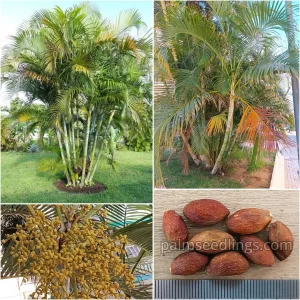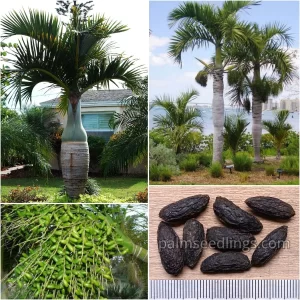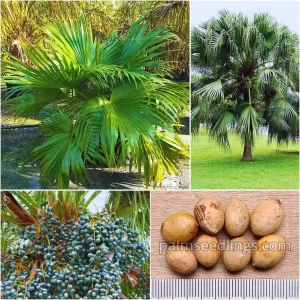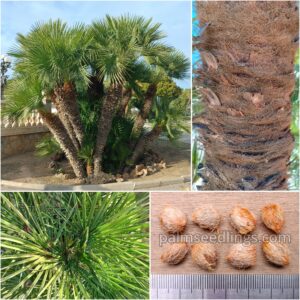Menu
4,00 € – 20,00 €
Product Details
Livistona decora, commonly known as the Weeping Cabbage Palm, is a graceful palm species admired for its slender trunk, cascading fronds, and ornamental value. Native to Australia, particularly in regions of Queensland, this palm species adds a touch of elegance to landscapes and gardens.
-Germination Rate: Very high
-Germination Time: Fast/Medium
-Germination Difficulty: Easy/Medium
-Growth speed: Medium/Fast
Select Quantity
*Shipping cost is calculated automatically in the cart after adding the products.
Livistona decora (Weeping Cabbage Palm)
Habitat:
Weeping Cabbage Palms are indigenous to subtropical and tropical regions of Australia, where they thrive in moist, well-drained soils. They are commonly found in rainforests, coastal areas, and along watercourses, where they benefit from high humidity and ample rainfall. These palms are often cultivated in gardens and parks for their aesthetic appeal.
Outstanding Features:
The most outstanding feature of the Weeping Cabbage Palm is its gracefully arching fronds, which cascade downwards in a weeping fashion. The fronds are glossy green, palmate, and deeply divided, creating a lush and tropical canopy. The trunk is slender, smooth, and light gray in color, adding to the palm’s ornamental value.
General Appearance:
Weeping Cabbage Palms typically grow to heights of 20 to 30 feet, with a spread of 10 to 15 feet. The trunk is topped with a crown of gracefully drooping fronds, giving the palm a weeping or cascading appearance. The overall silhouette is elegant and well-suited to tropical and subtropical landscapes.
Applications:
Weeping Cabbage Palms are highly valued for their ornamental beauty and are commonly used as focal points in gardens, parks, and landscapes. They are suitable for both tropical and subtropical garden styles and can be planted as specimen trees or in groups to create a lush, tropical effect. Additionally, these palms are occasionally used in commercial landscaping projects to enhance the visual appeal of outdoor spaces.
Adaptability:
Weeping Cabbage Palms are well-adapted to subtropical and tropical climates and prefer moist, well-drained soils. They thrive in locations with high humidity and ample rainfall but can tolerate occasional drought once established. These palms prefer partial shade to full sun and are relatively low-maintenance, making them a popular choice for tropical and subtropical gardens. Their graceful fronds and ornamental value make them a sought-after palm species for landscaping purposes.
| Weight | N/A |
|---|---|
| Quantity | 10 Seeds, 100 Seeds, 500 Seeds, 1.000 Seeds, 4.000 Seeds |




All rights reserved PalmseedlingsⓇ 2025.